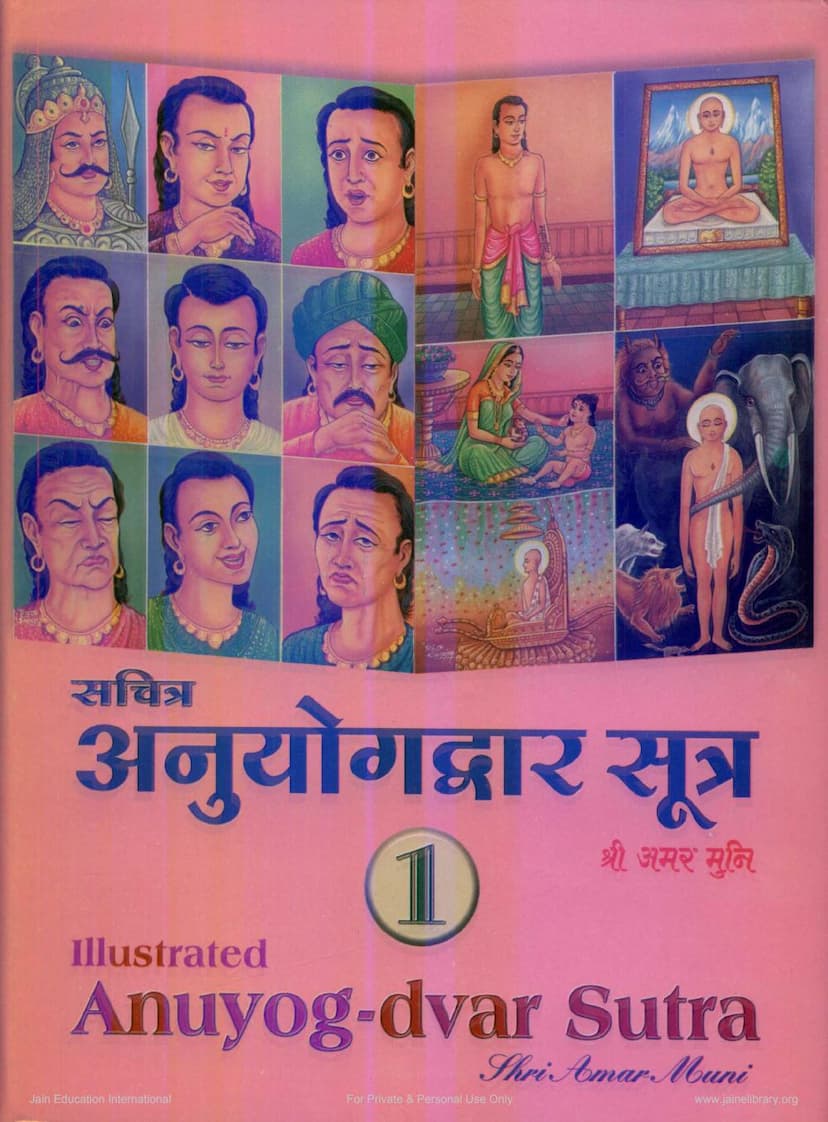Agam 32 Chulika 02 Anuyogdwar Sutra Part 01 Sthanakvasi
Added to library: September 1, 2025

Summary
The provided text is the first part of the "Anuyogdwar Sutra," compiled by Arya Rakshit Sthavir, edited by Shri Amar Muni, Shri Tarun Muni, and Srichand Surana, with English translation by Surendra Bothra and illustrations by Dr. Shri Trilok Sharma. The publication is by Padma Prakashan, Delhi.
This scripture is described as a unique and foundational text in Jain Agams, serving as a "gateway to the city of Agamic knowledge." It explains the methodology of interpreting Jain Agams, emphasizing that a single sutra can lead to vast and layered understanding, much like a drop expanding into an ocean.
Key aspects and themes discussed in the provided text include:
- The Importance of Scriptures (Shaastra/Agam): The text highlights the crucial role of scriptures in spiritual development, equating them to the eyes of the soul and the ruler of the soul, mind, and senses.
- Classification of Jain Agams: It mentions the existence of 45 Agams in the Shvetambar tradition and 32 in the Sthanakvasi tradition, listing the 32 Agams (11 Angas, 12 Upangas, 4 Chhed Sutras, 4 Mool Sutras, and Avashyak Sutra). Anuyogdwar is categorized as one of the four Mool Sutras, alongside Uttaradhyayan, Dashavaikalik, and Nandi.
- The Meaning of "Anuyoga": The core concept of "Anuyoga" is explained as the process of associating the correct and intended meaning with a word, considering the purpose, viewpoint (naya), and attribution (nikshep) used by the Tirthankaras. It's a method for understanding the profound meanings within scriptures.
- The "Four Doors" of Anuyoga: Anuyogdwar Sutra itself is structured around four interpretive approaches or "doors":
- Upakram (Introduction): This is the most extensive part, covering about 75% of the sutra. It involves understanding another's viewpoint and acting accordingly, explored through six angles: name, installation, substance, area, time, and essence.
- Nikshep (Attribution): This door explains how to understand fundamental truths through four lenses: name, installation, substance, and essence.
- Anugam (Interpretation): This section discusses the classification and interpretation of subjects.
- Naya (Viewpoint): This section details the seven nayas (viewpoints) used in Jain philosophy to understand reality from different perspectives.
- Diverse Content and Cultural Significance: The Anuyogadvar Sutra is noted for its rich content, including:
- Philosophical and Religious Material: Discussions on six substances (shad-dravya), qualities of the soul, body structures, life spans, etc.
- Mentions of Non-Jain Literature: It cites 19 famous non-Jain works like the Ramayana, Mahabharata, Kautilya, Vaisheshika philosophy, Buddha's teachings, etc., providing insights into the cultural milieu of its creation.
- Music and Musical Notes: A detailed description of the seven musical notes (Svara) and their origins.
- Grammar (Vyakaran): Discussion of eight case-endings (vibhaktis) and seven compound word structures (samasas).
- Navarasa (Nine Sentiments): A unique presentation of nine sentiments, including the inclusion of "Vridanak-rasa" (sentiment of shame) and a distinct "Prashant-rasa" (sentiment of serenity), differing slightly from traditional poetics.
- Samudrik Shaastra (Physiognomy): Descriptions of body marks and characteristics to distinguish individuals as good, average, or bad.
- Beliefs and Trades: Information about prevalent customs, attire, and professions in ancient India, suggesting that caste was based on karma rather than birth.
- Arts and Crafts: Mentions of artists skilled in acrobatics and other performances.
- Weights and Measures: Details about various systems of measurement prevalent in that era, reflecting developed trade practices.
- Compilation and Time Period: Anuyogadvar Sutra and Nandi Sutra are considered the most recent Jain Agams. While the exact author remains unclear, scholars attribute it to Arya Rakshit Suri, the twentieth spiritual descendant of Bhagavan Mahavir, placing its compilation in the sixth century of the Jain era (Vira Nirvana era 570-584 ANM, or 57-70 AD).
- Commentaries: The text mentions three ancient commentaries: the Churni by Jinvadash Gani Mahattar (7th century Vikram era), the Haribhadriya Vritti by Haribhadra Suri (8th century Vikram era), and the Maladhariya Vritti by Acharya Maladhari Hemchandra (12th century Vikram era).
- The Structure of the Edition: This publication is Part 1, covering sutras up to 262, with Hindi and English translations, elaborations, and colorful illustrations.
The introductory sections emphasize the importance of Anuyogdvar Sutra for understanding the interpretive methods of ancient Jain scriptures and highlight the detailed and balanced approach taken in this edition to elucidate complex philosophical concepts.